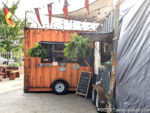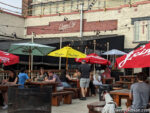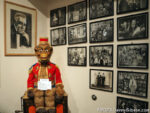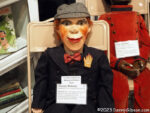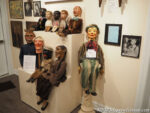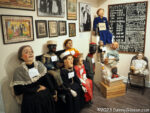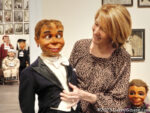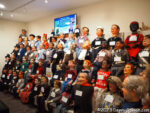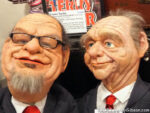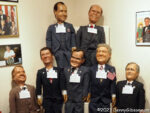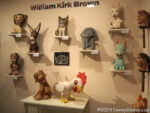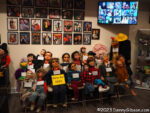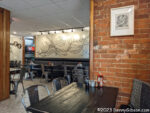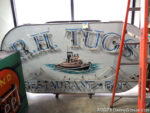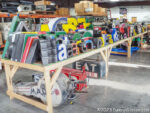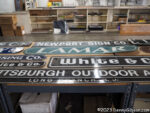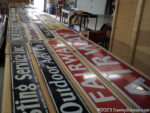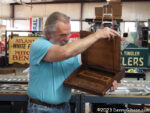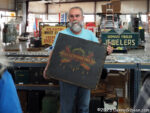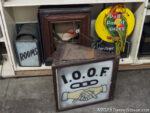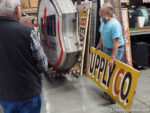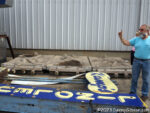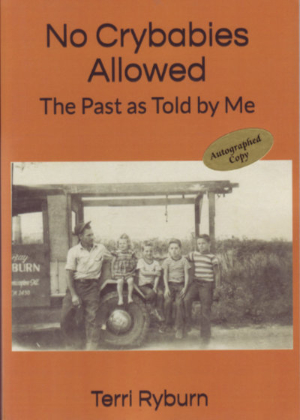 I know Terri Ryburn as the owner of historic Sprague’s Super Service in Normal, Illinois, and as a key ingredient in the Miles of Possibility Route 66 Conferences. I know the picture on the cover of the book from a copy hanging on the wall of the former gas station that Ryburn has turned into a Route 66 information center, gift shop, and photo op. I knew that was Terri seated on the fender with her dad and older brothers standing beside her because she told me when I spotted the photo on the wall. She may have told me that the photo contained only half of her total family but if she did I forgot. From reading No Crybabies Allowed I learned (or maybe relearned) that, while Terri was the youngest family member in this particular photo, she would be in the elder half of eight children after two more brothers and two sisters came along. None were crybabies.
I know Terri Ryburn as the owner of historic Sprague’s Super Service in Normal, Illinois, and as a key ingredient in the Miles of Possibility Route 66 Conferences. I know the picture on the cover of the book from a copy hanging on the wall of the former gas station that Ryburn has turned into a Route 66 information center, gift shop, and photo op. I knew that was Terri seated on the fender with her dad and older brothers standing beside her because she told me when I spotted the photo on the wall. She may have told me that the photo contained only half of her total family but if she did I forgot. From reading No Crybabies Allowed I learned (or maybe relearned) that, while Terri was the youngest family member in this particular photo, she would be in the elder half of eight children after two more brothers and two sisters came along. None were crybabies.
I didn’t care much for the book’s title when I first saw it. I may have liked it even less after encountering it in the text for the first time. Terri’s brothers started a “boys only” club which she, of course, wanted to join. When being told that girls were not allowed brought on tears, they told her that there were no crybabies allowed either. I was still calibrating the book in my mind at that point and I seriously feared that I was in for many pages of the boys driving their sister to tears then laughing at her or her refusing to let tears actually form to prove she was no crybaby. By then I’d read enough to know better but I guess I just didn’t.
But it wasn’t long before an entirely different view of the title started to form. The Ryburns were poor. Often very poor. Often very very poor. They lived in an apartment when Terri was born but were soon living in a tent and carrying water from a neighboring house. It was quite a step up when her father built “a windowless 10′ x 16′ tarpaper shack”. I’ve read more than a few tales of people living in poverty. It often seems like the writers make lots of comparisons and toss around adjectives to stress just how poor someone is. That is infrequently the case here. Situations are described in enough detail that comparisons can easily be made but they are not forced. I don’t believe there is a single instance of “we were so poor that…”. I began to think of the book’s title as Terri’s instruction to herself. Tell your story accurately but don’t whine about it.
The family’s financial situation was not helped by Ray Ryburn’s wanderlust. Their frequent moves over the western two-thirds of the country were always instigated by Terri’s father, sometimes with apparent justification and sometimes not. A typical move had them downsizing their already meager belongings to fit into whatever timeworn vehicle was in their possession at the time then cramming themselves into what space was left while Hazel Ryburn counted her offspring as they boarded to make sure none were left behind. That seems a little like the Joads and I don’t doubt that there were times when the Ryburns in transit resembled people fleeing the dust bowl a couple of decades earlier.
No Crybabies Allowed is autobiographical. It covers the first dozen years of Terri Ryburn’s life in chronological order. However, it is done with anecdotes that, in many cases, could stand alone as short stories of life in the 1950s or of being a child in any decade. Some, like the neighborhood prayer meeting, are hilarious. Others are about as far from funny as it is possible to be.
While the Ryburns are living in San Francisco, a very young Terri is invited to a prayer meeting by a Spanish-speaking neighbor. As the adult women pray loudly with hands in the air, a non-Spanish-speaking Terri joins them. For the most part, she relies on copying the other voices with a syllable or so lag but she also tosses in a few phrases of her own (e.g., caballero dog) that she learned by watching Zorro on TV. Some of the emotional women had begun to cry but the tears stopped as they opened their eyes to look at the enthusiastic visitor. Ending the crying, she decided, was proof that her prayers were working.
For an example of something at the other end of the scale, the bonfire scene as they prepare to leave Illinois for California is one that sticks in my mind. The bonfire is the final step in downsizing. Useless furniture and other items not making the trip go into the fire. The boys make a game of tossing their few toy cars and trucks into the fire. The same fate has been decreed for Linda, Terri’s doll. Terri at first refuses but eventually tosses the doll into the flames while tears flow. Linda has been through some rough times including the brothers using her head for a ball just a few pages earlier. She’s in pretty bad shape and somehow considering the doll’s sorry condition makes the toss acceptable. Maybe it’s just rationalizing the inevitable but that’s not a bad skill to master when dealing with the inevitable crops up so often. Ryburn didn’t write the following and maybe she didn’t even think it but I did. Sobbing over a doll does not make you a crybaby.
Terri (actually Theressa, I learned) Ryburn and I are about the same age so some of her childhood experiences parallel my own. I remember learning to read with Dick and Jane and I remember ordering books from the Scholastic Book Club. I remember weak Kool-Aid and peanut butter sandwiches. I suppose the familiar bits that brought back my own memories are one reason I enjoyed this book. But Ryburn and I don’t remember these things exactly the same way. I don’t recall ever having a problem getting a few quarters for my Scholastic Book Club order and our Kool-Aid almost always had some sugar in it. And we never moved beyond a few miles and not at all during my school years. Maybe — and I feel a tiny tinge of guilt saying this — I enjoyed the book because it made me appreciate the circumstances of my childhood even more.
The book can be purchased from Amazon via the link at the end but a better way would be to get an autographed copy direct from Terri at Ryburn Place, 305 Pine St, Normal, IL. Terri would also be happy to mail copies. Call (309-585-4103) or email (ryburnplace66@gmail.com) to arrange.
No Crybabies Allowed: The Past as Told by Me, Dr. Terri Ryborn, Independently published (December 9, 2019), 7 x 10 inches, 405 pages, ISBN 978-1093973686
Available through Amazon.

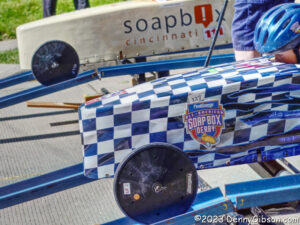
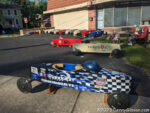
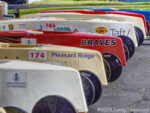

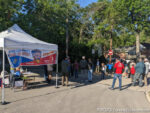






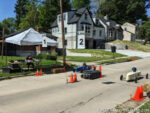
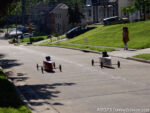

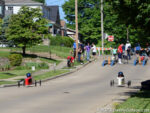
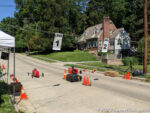
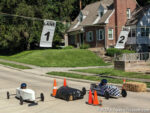
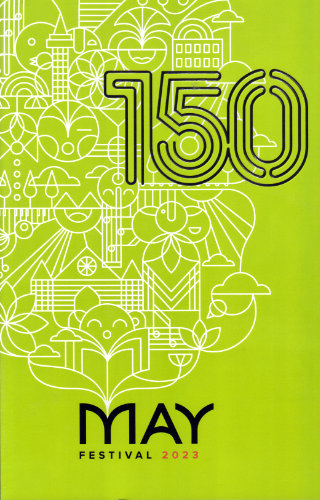 I did better this year than last, and last year I did better than in any of the preceding 148. As explained in a blog post (
I did better this year than last, and last year I did better than in any of the preceding 148. As explained in a blog post (







